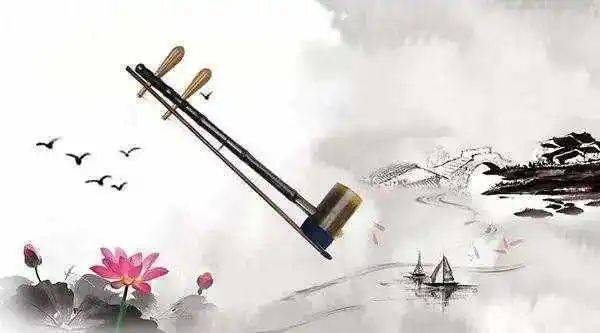The difference between matouqin and erhu
What is the difference between matouqin and erhu? Analyze their differences from the following aspects.

1. Appearance
Compared with Western violin instruments, matouqin and erhu have relatively slender stems (accounting for more than 60% of the total length of the piano), and the erhu is particularly slender. Both sound boxes are smaller. This is due to the traditional Chinese modeling and musical aesthetic orientation. In the structure of Chinese national musical instruments, the scientific nature of its construction was not within the scope of musical instrument makers. Musical instrument craftsmen are more concerned with the appearance of the instrument, such as the erhu, whose slender structure is an abstraction of the typical body shape of a standard Chinese.
Although Matouqin is currently a trapezoidal resonance box, it can be seen that its predecessor, Chaoer, has an inverted pear-shaped speaker. Or, kind of like a cross section of a horse's skull. Maybe the touching legend of Matouqin is also related to this.
2. Strings
The string is the vibrating body of the stringed instrument and the source of the sound. In the past, the strings of Chinese national musical instruments were usually twisted together by multiple strands of silk, and the same was true for the strings of the erhu. Since the 1950s and 1960s, improved metal strings have basically replaced silk strings, which has greatly improved the sound quality of the erhu's high position and broadened the erhu's range. However, unlike almost all stringed instruments in the world, the strings of the traditional matouqin are composed of a large number of scattered ponytails, which are combed into a bundle, not crossed, but pulled parallel to the piano. Therefore, the strings of the matouqin are not exactly two strings, but two bundles. After that, although the ponytail strings were replaced by nylon (Φ=0.15 or 0.18 mm), the feature of multiple strings forming a bunch of strings was completely preserved. This multi-string feature has almost become a feature that distinguishes the Matouqin from any other musical instrument in the world, and it has also become the sound basis for the Matouqin's unique timbre.
3. About the sound box
Accustomed to listening to the deep and rich timbre of modern matouqin, few people can think that the timbre of traditional matouqin is not very ideal. Like the erhu, the traditional matouqin is a leather-covered instrument. It's just that the erhu is generally covered with python skin, and the Jinghu is the green snake skin, in short, the snake skin. The matouqin has python skin, cowhide skin, and even horse skin. This shows from one aspect that in the not-too-distant past, the manufacture of matouqin was still very irregular, and there was no uniform standard. On the other hand, it fully illustrates the creativity of the owners of the matouqin, the grassland herdsmen, who use local materials and adapt measures to local conditions. Both of these aspects are common features of minority musical instruments.
As the value of matouqin is gradually recognized, its manufacture is becoming more and more standardized, and its improvement is becoming more and more scientific. Modern matouqin has generally used paulownia wood covering, imitating the sound conduction system of the western violin, and installing sound beams and sound columns in the resonance box. In order to facilitate the coordination and unity of the vibration of the surface and the back plate, and improve the sound quality.
This is a fairly scientific design, which is not available in the current erhu production. There is nothing in the conduction system of the erhu in the resonance tube except for the piano rod and a part of the double resonance tube structure of the Beijing Qin. At present, the material of high-end matouqin has completely imitated the violin, using spruce top, maple back and sides. The materials used are more and more rationalized, and the appearance is also beautiful. The sound box shape of the violin is an irregular shape, so the sound vibration pattern is very complex. Therefore, the overtone column of the violin is rich, especially the prominent fifth overtone, which makes the violin timbre gorgeous, the sound quality is concentrated, and it is easy to transmit far. Of course, the current level of craftsmanship and sophistication of matouqin is far from being comparable to that of erhu and violin. It needs to be improved as soon as possible to catch up.
4. The bow problem
Matouqin, as a member of the big family of Chinese musical instruments, the biggest difference from the erhu bow system is that the bow hair of the huqin is sandwiched between the two strings, while the bow of the matouqin is completely outside the strings, which is the so-called "liberation" The bow string system is similar to the shape and performance of the violin bow. The liberation of the bow has many advantages, such as the simplest, double-tone can be played, which is impossible in the traditional Huqin technique. Matouqin's bow hair is elastic, so-called "hard bow", while the erhu's bow hair is looser, so-called "soft". In addition, the liberation of the bow and the "hard bow" are conducive to the display of various skills of the right hand, which is a more advanced system than the bowing system of the huqin. Of course, the liberated "hard bow" also has its shortcomings, which is reflected in the control of the bow, including the trajectory, angle and strength of the bow, which require high requirements, and it is easy to cause tension in the right forearm and affect the performance.
In a word, in terms of structure, the difference between the modern matouqin and the violin is smaller than that of the erhu, but it still maintains the basic elements of the Chinese national musical instrument and its own unique characteristics.
 渝公网安备 50010702504639号
渝公网安备 50010702504639号